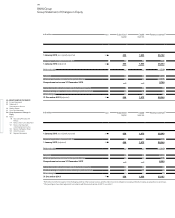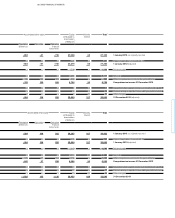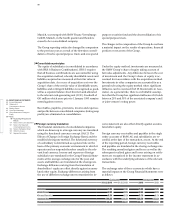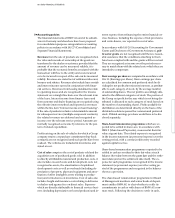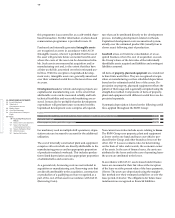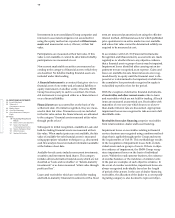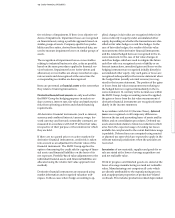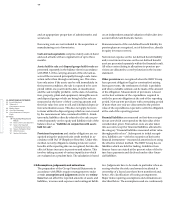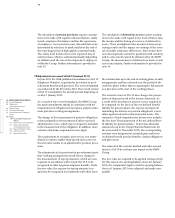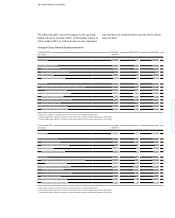BMW 2013 Annual Report Download - page 99
Download and view the complete annual report
Please find page 99 of the 2013 BMW annual report below. You can navigate through the pages in the report by either clicking on the pages listed below, or by using the keyword search tool below to find specific information within the annual report.
99 GROUP FINANCIAL STATEMENTS
Accounting policies
The financial statements of BMW AG and of its subsidi-
aries in Germany and elsewhere have been prepared
for consolidation purposes using uniform accounting
policies in accordance with IAS 27 (Consolidated and
Separate Financial Statements).
Revenues from the sale of products are recognised when
the risks and rewards of ownership of the goods are
transferred to the dealer or customer, provided that the
amount of revenue can be measured reliably, it is
probable that the economic benefits associated with the
transaction will flow to the entity and costs incurred
or
to be incurred in respect of the sale can be measured
reliably. Revenues are stated net of settlement discount,
bonuses and rebates. Revenues also include lease rentals
and interest income earned in conjunction with
finan-
cial services. Revenues from leasing instalments relate
to operating leases and are recognised in the income
statement on a straight line basis over the relevant term
of the lease. Interest income from finance leases and
from customer and dealer financing are recognised using
the effective interest method and reported as revenues
within the line item “Interest income on loan financing”.
If the sale of products includes a determinable amount
for subsequent services (multiple-component contracts),
the related revenues are deferred and recognised as
income over the relevant service period. Amounts are
normally recognised as income by reference to the pat-
tern of related expenditure.
Profits arising on the sale of vehicles for which a Group
company retains a repurchase commitment (buy-back
contracts) are not recognised until such profits have
been
realised. The vehicles are included in inventories and
stated at cost.
Cost of sales comprises the cost of products sold and the
acquisition cost of purchased goods sold. In addition
to directly attributable material and production costs, it
also includes research costs and development costs not
recognised as assets, the amortisation of capitalised
development costs as well as overheads (including de-
preciation of property, plant and equipment and amor-
tisation of other intangible assets relating to produc-
tion) and write-downs on inventories. Cost of sales also
includes freight and insurance costs relating to deliveries
to dealers and agency fees on direct sales. Expenses
which are directly attributable to financial services busi-
ness (including depreciation on leased products) and in-
terest expense from refinancing the entire financial ser-
vices business, including the expense of
risk provisions
and write-downs, are reported in cost of
sales.
In accordance with IAS 20 (Accounting for Government
Grants and Disclosure of Government Assistance),
pub-
lic sector grants are not recognised until there is
reason-
able assurance that the conditions attaching to them
have been complied with and the grants will be received.
They are recognised as income over the periods neces-
sary to match them with the related costs which they are
intended to compensate.
Basic earnings per share are computed in accordance with
IAS 33 (Earnings per Share). Basic earnings per share
are calculated for common and preferred stock by di-
viding the net profit after minority interests, as attribut-
able to each category of stock, by the average number
of outstanding shares. The net profit is accordingly allo-
cated to the different categories of stock. The portion of
the Group net profit for the year which is not being
dis-
tributed is allocated to each category of stock based on
the number of outstanding shares. Profits available for
distribution are determined directly on the basis of the
dividend resolutions passed for common and preferred
stock. Diluted earnings per share would have to be dis-
closed separately.
Share-based remuneration programmes which are ex-
pected to be settled in shares are, in accordance with
IFRS 2 (Share-based Payments), measured at their fair
value at grant date. The related expense is recognised
in the income statement (as personnel expense) over the
vesting period, with a contra (credit) entry recorded
against capital reserves.
Share-based remuneration programmes expected to be
settled in cash are revalued to their fair value at each
balance sheet date between the grant date and the settle-
ment date (and on the settlement date itself). The ex-
pense for such programmes is recognised in the income
statement (as personnel expense) over the vesting pe-
riod of the programmes and recognised in the balance
sheet as a provision.
The share-based remuneration programme for Board
of
Management members and senior heads of depart-
ment entitles BMW AG to elect whether to settle its
commitments in cash or with shares of BMW AG
com-
mon stock. Following the decision to settle in cash,
5







